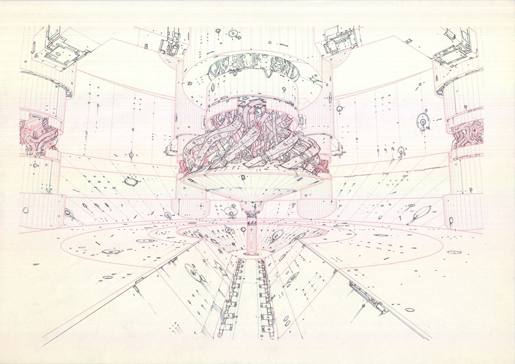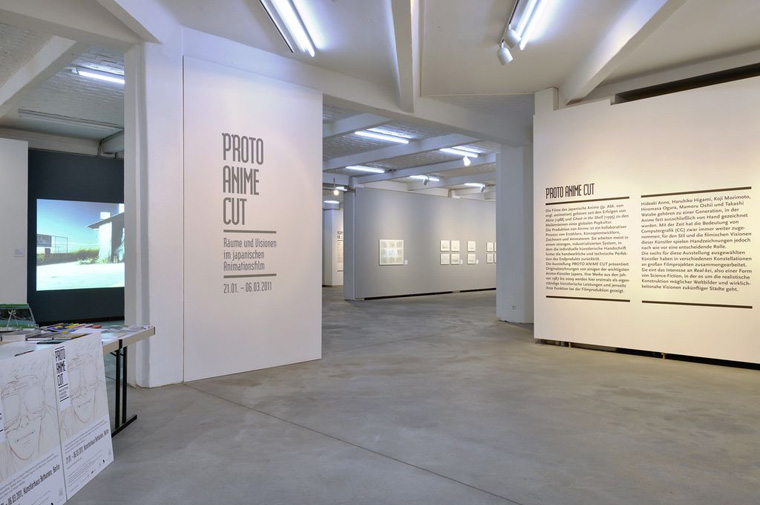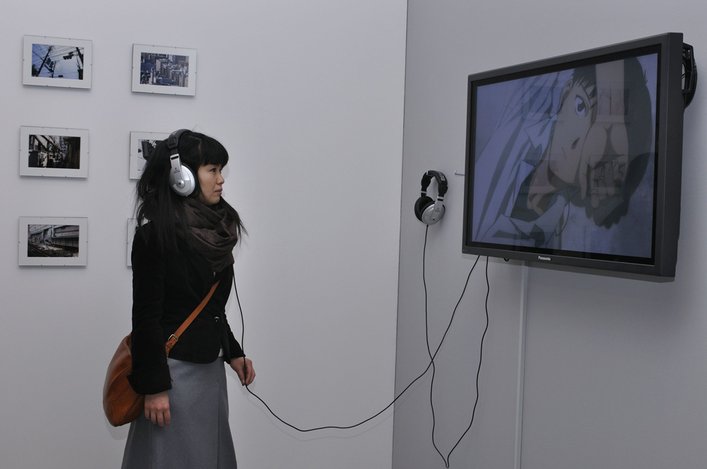
Takashi Watabe. Layout for Evangelion: 2.0 You Can (Not) Advance (2009), Cut 710. With kind permission of Studio Khara and Universum Film.
Since the success of Akira (1988) and Ghost in the Shell (1995), Japanese anime films have been among the most important milestones in global pop culture. The action-packed hero stories and the visionary science fiction of Japanese Anime are set in impressive worlds that are constructed in painstaking detail. Looking at the creative processes, the filmmakers appear as architectural dreamers who operate with virtuosity at the borders of credibility, fiction and utopia. The exhibition focuses on the development of these arenas of action and narrative scenarios. Numerous background paintings, storyboards, drafts, sources of inspiration and film excerpts provide insight into the working methods of the most successful animation artists of the last two decades.

Evangelion: 2.0 You Can (Not) Advance (2009). Cut 710, still image. With kind permission of Studio Khara and Universum Film.
The exhibition includes work by Hideaki Anno (director, Neon Genesis Evangelion), Haruhiko Higami (photographer), Koji Morimoto (director, Dimension Bomb), Hiromasa Ogura (art director), Mamoru Oshii (director, Patlabor, Ghost in the Shell) and Takashi Watabe (layout).
The presented artists have played key roles in the development of Anime. By cooperating closely in different production studios in Tokyo they gave their distinctive signatures to many films and developed the prototypical Anime style. Their works, from 1987 to 2009, are shown for the first time as individual works of artistic creativity, beyond their role in the production of films. The six artists selected for this exhibition have worked together on major film projects in various configurations. They are united by their interest in real-kei, a form of science fiction that deals with the realistic design of possible worldviews and realistic visions of the future.
Oshii Mamoru puts emphasis on the layout and the background design and is one of the most influential directors in Japan (Patlabor – The Movie (1989), Ghost in the Shell (1995), Ghost in the Shell 2: Innocence (2004)). The realistically painted backgrounds by Hiromasa Ogura are rich in detail that allows the viewer to be aware of his handwork at all times. The artwork of Hideaki Anno is characterised by an extremely complex scenario, great sensitivity to older animation styles and psychologically accurate portrayal of the characters. Shaping the style of Takashi Watabe is his near-obsessive attention to detail. He contributes significantly to the believability of so many future-scenarios in science fiction anime with everything from seemingly irrelevant details to elaborate designs.

Proto Anime Cut – Spaces and visions in Japanese animation is a project by Les Jardins des Pilotes (Berlin) in cooperation with 2dk (Tokyo) and is curated by Stefan Riekeles and David dʼHeilly. Being co-produced by Obra Social Caja Madrid (Spain) the exhibition will also be shown in 2012 in Barcelona and Madrid. The publication Proto Anime Cut Archive will be released by the publisher Kehrer.

Visitor watching an excerpt from Hideako Anno’s Evangelion: 1.0 You Are (Not) Alone (2007). In the background, photos by Anno which serve as source of inspiration.
With works by: Hideaki Anno (JP), Haruhiko Higami (JP), Koji Morimoto (JP), Hiromasa Ogura (JP), Mamoru Oshii (JP), Takashi Watabe (JP).
Curated by: Stefan Riekeles (Les Jardins des Pilotes, Berlin) and David dʼHeilly (2dk, Tokyo).
Opening: Friday, 8 July 2011, 18:00 (3rd floor of the Dortmunder U).
Location: Hartware MedienKunstVerein (HMKV) Dortmunder U (3rd floor) Leonie-Reygers-Terasse 44137 Dortmund, Germany.


























